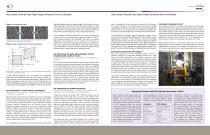 Website:
Vision Research
Website:
Vision Research
Group: AMETEK
Catalog excerpts

High-Speed Cameras Help Digital Image Correlation Show Its Strength By Nicholas Long, OEM Manager, and Doreen Clark, Sr. Product Manager, Vision Research igital image correlation (DIC) is an optical measurement technique that allows fullfield analysis of a material’s or structure’s deformation, displacement, and strain. The popularity of the technique is growing, especially in the aerospace, defense, and automotive industries where DIC is used to test the strength and load response of various parts and materials. High-speed cameras and various software packages are helping DIC expand into new applications while also ensuring the technique delivers quality quantitative data. DIC can be performed using either a single camera or multiple cameras that have been synchronized to record at various angles. Utilizing one camera will produce a 2-D image, for analyzing elongation, tensile strength or single plane distortion. Multiple camera systems, used more often in DIC, produce 3-D images and are used in applications such as vibration testing or distortion analysis on multiple planes. To perform DIC, a specially prepared random speckle pattern is applied to the surface of the sample and the movement of that pattern is recorded and analyzed to reveal areas of strain and displacements. Figure 1 (on the next page) shows an example of a random speckle pattern being tracked, and Figure 2 (on the next page) shows an example of how the tracking corresponds to measurements of strain and displacement. While the traditional method of placing sensors directly on an object can gather strain and movement information, DIC offers a more practical approach with several advantages: 1. DIC is a non-contact technique, eliminating additional weight, electrical biases, and delicate sensor bonding. 2. DIC provides measurements from many points over an area, providing more information than sensors without the need to repeat measurements. 3. DIC delivers quantitative data suitable for engineering, including absolute measurements, not just relative data. 4. DIC is less time consuming and can be easily connected to the design cycle. methods using applications, DIC can provide more quantitative information than traditional
Open the catalog to page 1
High-Speed Cameras Help Digital Image Correlation Show Its StrengthHigh-Speed Cameras Help Digital Image Correlation Show Its Strength Image courtesy of C.Y. Chang; L.C. Chen; W.C. Lee; and C.C. Ma. 2015, Measuring Full-Field Deformation and Vibration Using Digital Image Correlation. In many difficult applications, DIC can provide more quantitative information than traditional methods using sensors, making it a strong solution to gather accurate measurements. While each of the following examples exploits more than one DIC advantage, they are useful in highlighting a specific advantage....
Open the catalog to page 2
types of impact that simulate real-world situations. These types of applications require cameras that can image fast enough to capture the quickly changing speckle pattern. Studying impact or fast loading situations can require a trade-off in camera resolution to achieve the high frame rates needed. Cameras that acquire tens of thousands of frames per second with 1 megapixel or less resolution work well for these applications. Some applications, such as vibration testing to discover how much a new dashboard material might vibrate under different road conditions, require extremely fast...
Open the catalog to page 3All Vision Research catalogs and technical brochures
-
PHANTOM S711
4 Pages
-
PHANTOM S641
4 Pages
-
PHANTOM Miro® C321 Airborne
4 Pages
-
PHANTOM TE2010
4 Pages
-
PHANTOM T4040 T2540
4 Pages
-
PHANTOM S991
4 Pages
-
Miro C
4 Pages
-
VEO-SERIES
4 Pages
-
TMX-SERIES
4 Pages
-
Phantom S640
2 Pages
-
Phantom VEO 1310
2 Pages
-
CineMag V and CineStation
2 Pages
-
N5
2 Pages
-
S200
2 Pages
-
v2512
4 Pages
-
v2640 ONYX
4 Pages
-
Workflow Whitepaper
4 Pages
-
Schlieren Whitepaper
4 Pages
-
Explosives Whitepaper
6 Pages
-
Microfluidics Whitepaper
3 Pages
-
Phantom® Flex4K-GS
4 Pages
-
Phantom® VEO
6 Pages
-
Phantom® VE04K
4 Pages
-
Phantom® VEO4K-PL
4 Pages
-
Flex4K
4 Pages
Archived catalogs
-
PHANTOM T1340
4 Pages
-
Phantom® v1840 / v2640
4 Pages
-
v2640
4 Pages






























